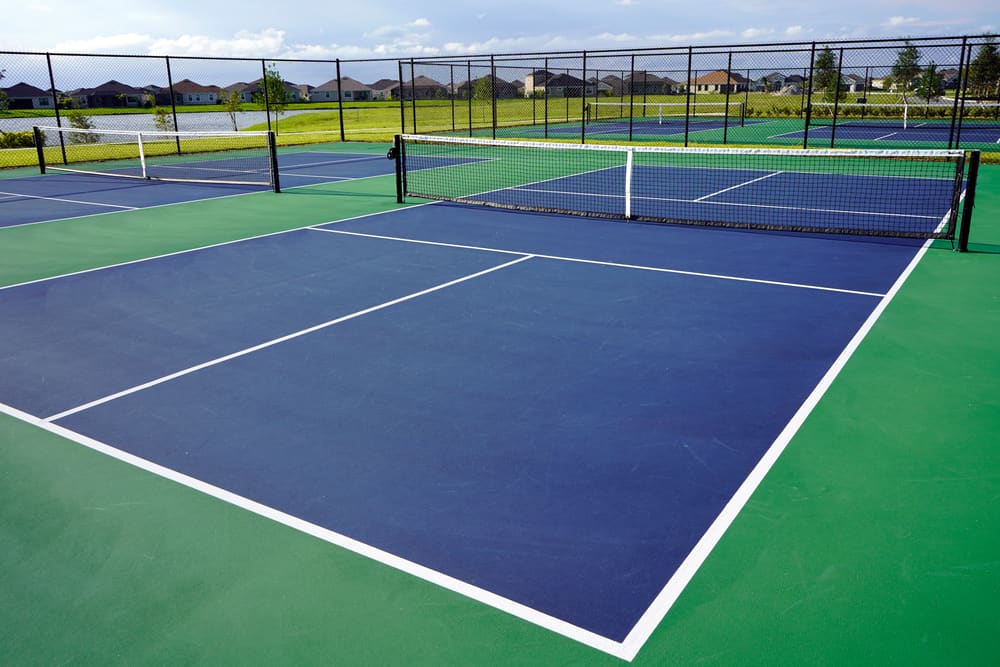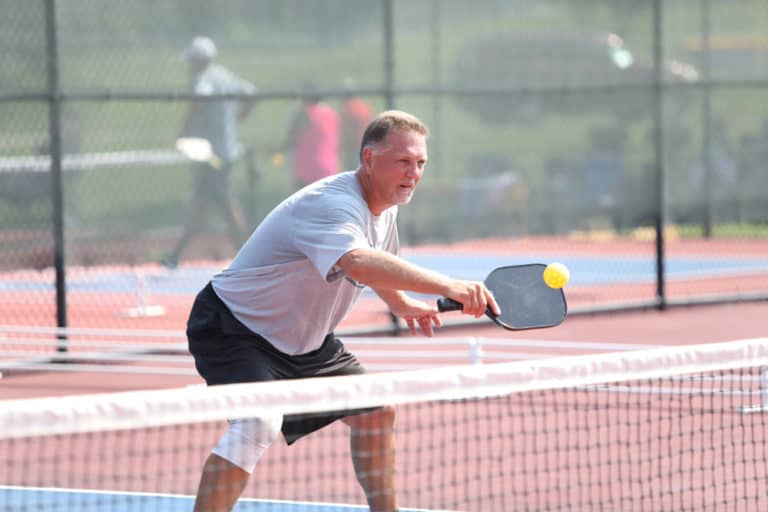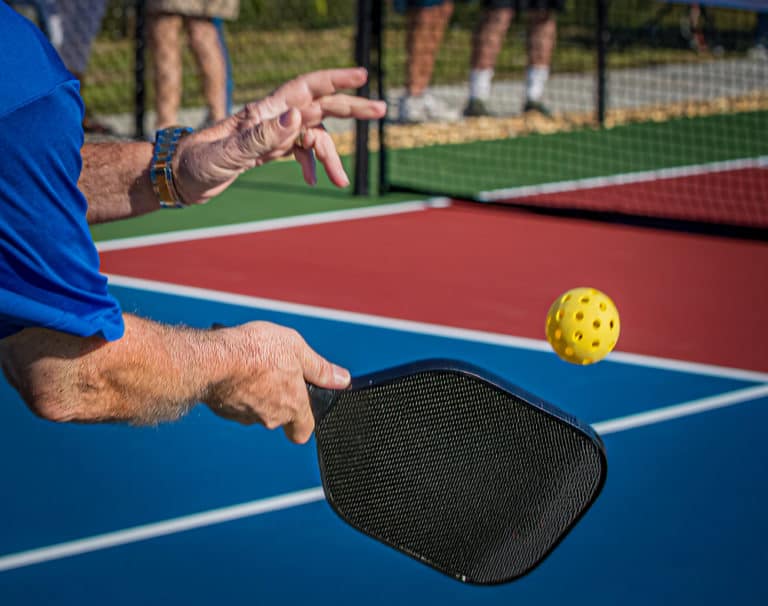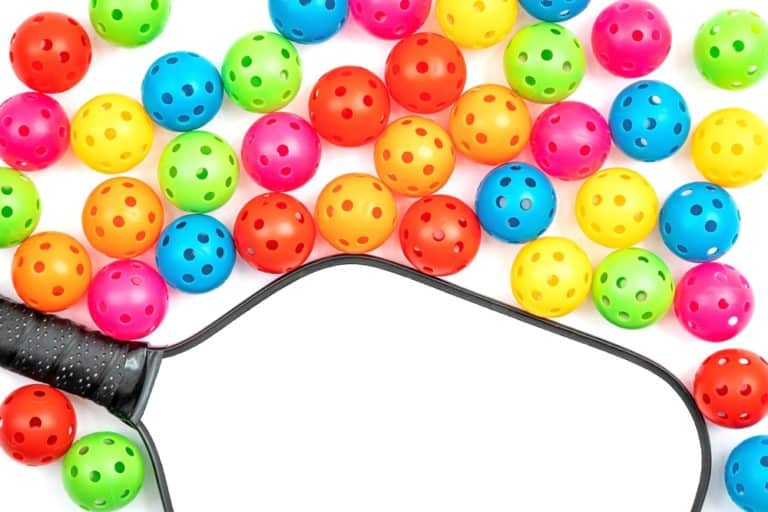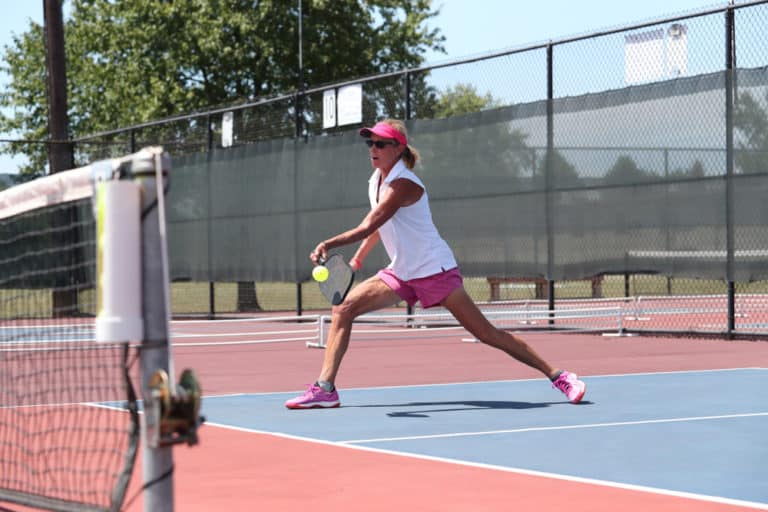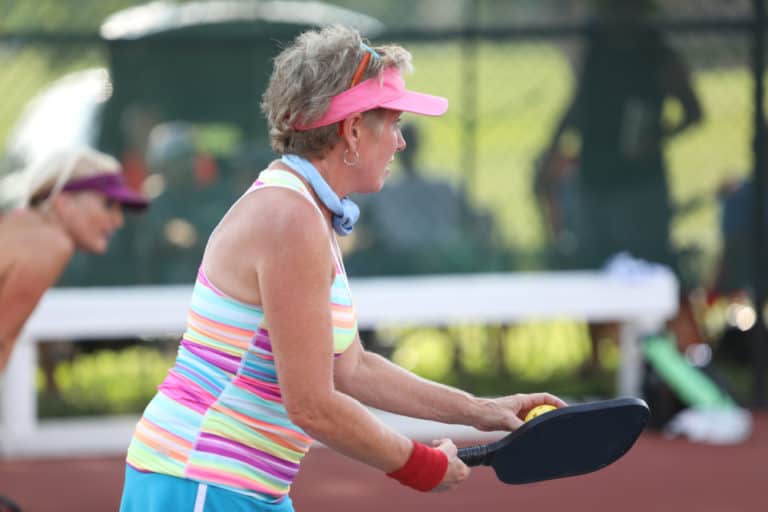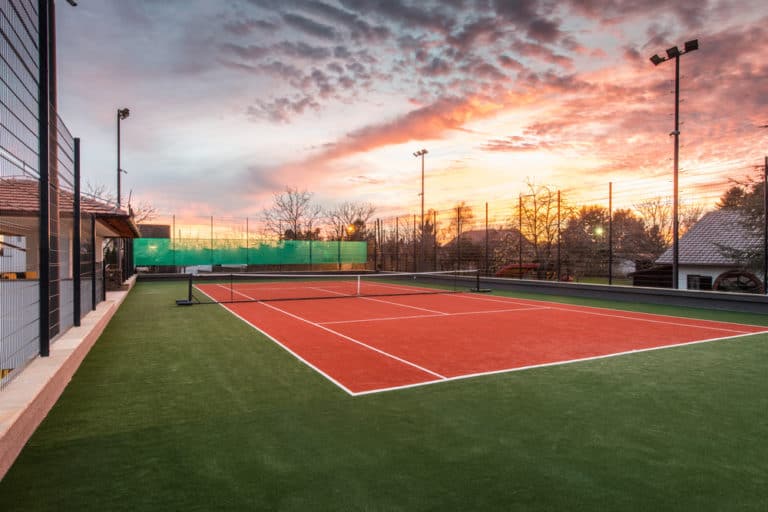Is A Pickleball Court The Same Size As A Badminton Court?
Pickleball is not only enjoyable, but it is also beneficial to one’s health. With that in mind, recognizing the sport’s boundaries is essential for really getting into the swing of things. Many individuals find that pickleball courts are comparable to badminton courts in size after watching the sport. That said, are pickleball courts the same size as badminton courts?
A pickleball court is 20 x 44 feet long and is the same size as a doubles badminton court. A pickleball net height is 36 inches at the sides and 34 inches at the center. Although it is the same size as a court used for doubles in badminton, pickleball can be played either singles or doubles.
A pickleball court resembles a badminton court diagram with two exceptions. First, the net on a pickleball court is lower than on a badminton court, and second, in badminton, the no service line is 6.5 feet from the net, but in pickleball, the no volley zone is 7 feet from the net. So with that in mind, let’s compare a closer look at pickleball and badminton similarities.
Comparing Pickleball And Badminton Court Sizes
A competitive racket sport similar to badminton, pickleball has become one of the newest sports to grow rapidly in the United States. Pickleball, when compared to badminton, is played with a Wiffle ball instead of a shuttlecock; pickleball combines elements of tennis, ping-pong, and badminton, and before you hit the ball with your paddle, it is allowed to bounce.
However, pickleball and badminton court measurement dimensions have many similarities. That said, starting with the badminton doubles play, here’s what to know about pickleball and actual size of badminton court.
Badminton Doubles Court Size
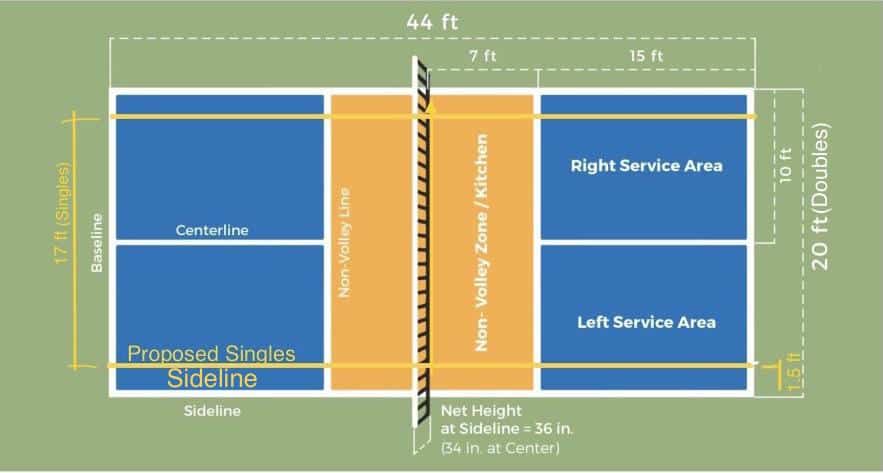
The rectangular surfaces used for the racket sport of badminton are known as badminton courts. Courts are normally restricted for both singles and doubles games, with boundary widths differing between the two-match types, and are divided in half by a central badminton net. Badminton courts should be paved with safe flooring materials such as wood, synthetic, and rubber for safe gaming.
Badminton court length is 44′ (13.4 m), but double courts are 20′ (6.1 m) wide, while single courts are 17′ (5.18 m), with 1.5′ (.46 m) narrowing on each side. A central line divides the width of the court, and a 6.5″short service line’ separates the service courts from the net (1.98 m).
A ‘long service line,’ which is 2.5′ (.76 m) in from the back boundary, is also required in doubles games. Around the whole badminton court, clearances of 2′ (.61 m) should be provided.
Pickleball Court Size
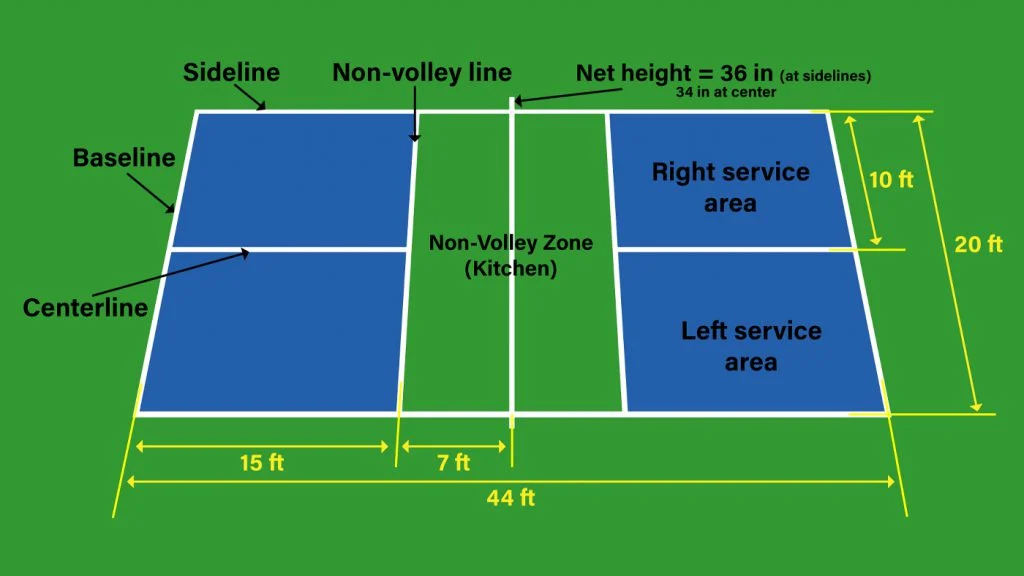
Pickleball courts should measure 20′ x 44′ for both singles and doubles. The entire court size is the same as in badminton. The net measures 36″ on the ends and 34″ in the center line, down from the regular badminton height. It’s best to provide enough room outside the end and sidelines for player movement when setting out the court.
As a result, we recommend that the whole court (including out-of-bounds sections) be at least 24′ x 54′ in size. If space allows, a 30′ by 60′ arena is said to be optimum for allowing the greatest athletic level of play. The exact measurements of a pickleball court may be found in the image above.
What Are Kitchen Rules For On A Pickleball Court?
The non-volley zone, which is the region between the net and the non-volley line, is one of the most important areas of the pickleball court (located 7 feet behind the net). It is often referred to as the “kitchen.”
The pickleball kitchen operates under a distinct set of regulations than the rest of the court. A volley is not permitted in this location. A fault will occur if you attempt to volley the ball in this location.
Volley happens when a player strikes the pickleball out of the air instead of waiting for it to bounce. Hitting a volley may enhance the pace of the ball and is effective for high balls that would otherwise take a lot of backing up to allow them to bounce.
A groundstroke, or the act of striking the ball after it has rebounded, is the inverse of a volley. These strokes, which frequently land far into the court, are utilized to maintain extended rallies and to run down the opponent. Comprehending these two pickleball words is essential for understanding the kitchen rules.
As a result, you must be aware of quite a few pickleball regulations to enjoy the game fully. Part of this is connected to the kitchen.
Non-Volley Zone Rules For Pickleball
A volley is typically understood as hitting the ball out of the air before the ball bounces. The kitchen’s most basic regulation is that it is a no-volley zone. No balls may be struck out of the air within its boundaries. Before being struck, the ball must bounce. Volleys may only be hit beyond the non-volley line, between that line and the court’s baseline. Furthermore, here are some pointers to note down.
- Players cannot touch the non-volley zone while volleying. It includes no part of your body, what you are wearing, or what you may be touching in the process of a volley. For example, when playing doubles, your partner can be in the kitchen during the volley, as long as you don’t touch them during the play.
- Both feet must contact the playing surface outside the non-volley zone before and after hitting a volley.
- If your paddle touches the non-volley zone as you volley, this counts as a fault. After a volley, it includes dropping your paddle, hat, sunglasses, or keys in the non-volley zone.
Many individuals believe that the non-volley zone includes the 3-D space/air above the court. However, this is not the case.
The non-volley zone only includes the flat surface of the court itself, which includes the lines all the way to its very edges. To clarify, you can stand in the non-volley zone and volley the ball after the ball has bounced.
How Is Pickleball Similar To Badminton?
Pickleball and badminton have numerous similarities. One thing they share is that their regulations are extremely similar. As a result, below are some key features both sports share.
- Both can be played as singles or as doubles.
- Both require a paddle or racket to hit a ball or shuttle over a net.
- Players have just one shot in both sports to get the ball past the goal line.
- The two sports courts are about the same size and proportions.
- Neither sport requires long-distance running, but both require short bursts of speed.
- Finally, there are options to play pickleball and badminton locally.
Pickleball Fitness Comparison
Pickleball, when played correctly, works on all six skill-related components of fitness. Some fitness components are employed more than others, but they are all exercised in some fashion.
- Speed is defined as the ability to traverse a distance in a short amount of time by completing a movement. If you’re playing against a competent opponent, they’ll frequently try to hit the ball far away from where you’re standing, so you’ll need to move quickly to get to the ball before it bounces twice.
- Agility: This is defined as the skill to change direction rapidly and accurately. Like the last point, if your opponent is a great player, they may try to fake where they will hit the ball; thus, you may have to shift course to get to the ball in time swiftly.
- Power – The term “power” refers to the employment of explosive motions. Pickleball players need power because they must smash the ball hard enough (and with enough power) to return it over the net successfully.
- Balance: The ability to maintain equilibrium when fixed or moving. Pickleball players must maintain good balance while moving to smash the ball properly because the game requires a lot of movement.
- Coordination uses senses and bodily components to work together to complete motor activities. It is significant in pickleball because players must employ coordination to smash the ball with the paddle.
- Reaction Time – The time between stimulus and response is the reaction time. It is critical to have a rapid response time to recognize where the ball was struck in pickleball and swiftly shift your body to smash the ball in time. It is especially crucial when your opponent hits the ball hard since you will have less time to respond to where it is heading.
Pickleball can give a tremendous exercise if played correctly and against difficult opposition. Players must traverse a huge amount of ground in a short amount of time, especially when playing singles. Players will break a sweat after playing pickleball for an extended time, and their heart rates will rise.
Pickleball may significantly enhance players’ cardiorespiratory and muscular endurance when played for an extended period. Pickleball is an excellent method for individuals to get active and live a healthy lifestyle.
Badminton Fitness Comparison
Badminton, like pickleball, also focuses on each of the six skill-related components of fitness when played correctly. Some fitness components are employed more than others, but they are all exercised similarly. Like the pickleball example, below are elements of how fitness would play a similar role in badminton.
- Speed: When playing against a competent opponent, they will frequently aim to strike the shuttlecock far away from where you are standing. As a result, speed is frequently necessary to reach the shuttlecock before reaching the ground.
- Agility: Like the last point, if your opponent is a skilled player, they will try to fool you by faking where they will hit the shuttlecock. As a result, players must occasionally change directions swiftly to reach the shuttlecock in time.
- Power: In badminton, power is needed because players must hit the shuttle hard enough (and with enough force) to return it over the net effectively.
- Balance: Due to the amount of movement involved in badminton, players must maintain good balance while moving to hit the shuttle properly.
- Coordination is significant in badminton because players must use coordination to hit the birdie with the racket.
- Reaction Time: In badminton, it is critical to have a rapid response time to recognize where the shuttle has been struck and swiftly shift your body to strike the shuttle in time. It is especially crucial when your opponent hits the shuttle forcefully since you will have less time to respond to where it is heading.
Badminton, like pickleball, can give a tremendous exercise if played correctly and against difficult opposition. Players must traverse a considerable amount of ground in a short amount of time, especially when playing singles. After playing badminton for a lengthy time, players will break a sweat, and their heart rates will rise.
Badminton may significantly enhance players’ cardiorespiratory and muscular endurance if played for an extended period. Overall, badminton is an excellent method for individuals to be active and live a healthy lifestyle.
How Do Badminton And Pickleball Differ
While pickleball and badminton have many similarities, they also have notable distinctions. For example, the equipment utilized is one distinction. As a result, let’s take a closer look into the differences.
- Pickleball is played using a ball similar to a Wiffle ball, whereas badminton is played with a shuttlecock (or birdie). Furthermore, pickleball employs paddles instead of badminton, which uses rackets (similar to tennis rackets but slightly smaller and lighter).
- The two courts are also slightly different. The height of the nets is the most noticeable variation between the courts. The net in pickleball is substantially shorter, at only 36 inches. On the other hand, the net in badminton is substantially taller, at a little over 5 feet.
- Another significant distinction between the two games is scoring. Rally scoring is used in badminton. It implies that a point is awarded after each round. As a result, badminton games are played to a score of 21.
- On the other hand, pickleball does not allow for rally scoring; only the serving team may score a point. It makes scoring more difficult, so pickleball games are limited to only 11.
- Another significant distinction between the two games is that the ball in pickleball can collide with the ground. In reality, the ball must bounce once per serve and once on the initial return. However, in badminton, the shuttle cannot touch the ground.
Conclusion
Whether you are currently playing pickleball or badminton and are considering participating in the other, know that you would easily be able to adapt since the differences are not that severe.
That said, if you are used to playing doubles in badminton, then a pickleball court size will not feel like much of a difference in terms of the playing field. With a few distinctions from both the sports, they encourage fitness and competition that suits all ages.

